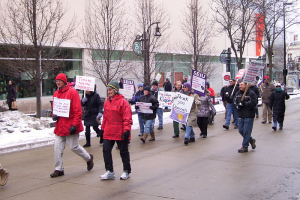 Both major party presidential candidates in 2012 seem committed to spending time and money campaigning in Wisconsin, and a few pundits have even speculated that the upcoming election might be decided by the votes of the Badger State.
Both major party presidential candidates in 2012 seem committed to spending time and money campaigning in Wisconsin, and a few pundits have even speculated that the upcoming election might be decided by the votes of the Badger State.
Local enthusiasm aside, how likely is it that Wisconsin’s electoral votes could actually decide the presidential election? Unfortunately, if history is any guide, not very likely.
Since their state’s admission to the United States on May 29, 1848, Wisconsinites have voted in 41 presidential elections, and the state has supported the winning candidate 32 times.
In ten consecutive elections from 1948 until 1984, the Badger state sided with the winning candidate, and had it not been for the surprising decision to support Dewey over FDR in 1948—after voting for Roosevelt by large margins in the three previous elections—the streak would have been 15 in a row.
However, in only one election—that of 1876—did Wisconsin’s votes actually matter, at least in the sense that in all the other elections, had Wisconsin gone with the losing candidate, the result would still have been the same.
The 1876 election was the closest election in American history, with a final electoral vote count of 185 votes for Republican Rutherford B. Hayes and 184 votes for Democrat Samuel Tilden. (Students of American history know that these totals were established only after the creation of a special electoral commission to sort out conflicting returns from several Southern states.)
Not only was the 1876 presidential election extremely close on a national level, it was extremely close in Wisconsin as well. Wisconsin voters cast 50.57% of their votes for Hayes, a percentage that only slightly exceeded the 48.19% of the votes cast for Tilden. (The remaining 1.24% went to minor party candidates.) Had Wisconsin cast its 10 electoral votes for Tilden instead of Hayes, the New York Governor would have won the election 194 electoral votes to 175.
There is actually little reason to be surprised that In no other election did the Wisconsin vote determine the outcome. While the popular vote in American presidential elections is often fairly close, in terms of the vote in the Electoral College, there have been very few close presidential elections in U.S. history. Given that Wisconsin’s number of electoral votes has never been greater than 13 and has been as few as 5, only a very close election could be decided by Wisconsin’s vote.
In fact, the only two other presidential elections since 1848 that could have been decided by the votes of a state the size of Wisconsin were the elections of 1916 and 2000. In 1916, incumbent president Woodrow Wilson defeated United States Supreme Court Justice Charles Evans Hughes by a margin of 277 to 254, in a year in which Wisconsin had 13 electoral votes. However, because Wisconsin supported Hughes, its votes did not affect the outcome of the election.
The same was true for the 2000 election in which George W. Bush edged Al Gore, 271 to 266, with Wisconsin casting its votes for Gore by a razor thin margin.
Of course it is possible that Wisconsin could make the difference. Were Mitt Romney to carry Indiana, plus all the Southern states except Maryland and Delaware and carry all the states west of the Mississippi River except Minnesota, New Mexico, Nevada, Washington, Oregon, and California, and carry Alaska, and were President Obama to carry all of the other states, the election would be decided by the candidate that carried Wisconsin.


